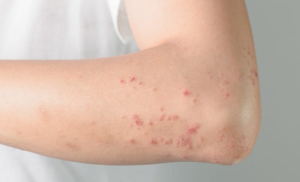
There are several types of allergies that can be caused by different allergens. Skin allergy is a reaction of the skin to these. Through this article, you will discover effective ways to fight against allergies and prevent them from recurring.
Allergies
The body fights different kinds of enemies, like microbes and viruses. To do this, he uses a powerful weapon called the “immune system”. When the latter considers that the body has ingested a substance called an “allergen”, it begins to react. The absorption in question can be done by touch, by breathing, but the allergen can also have been consumed or drunk. Thus, the immune system begins to produce an antibody called IgE to fight against the allergen. This is where the allergic reaction begins. The allergy is known as type 1 hypersensitivity. It manifests itself in various places in the body, including the eyes, skin, respiratory tract or digestive system . Allergic reactions are sometimes discreet and appear as a simple redness on the skin. Other signs like anaphylaxis are potentially life-threatening.
There is reason not to confuse intolerance and allergy. If the reaction is not due to IgE, it is not an allergy, but an intolerance. This is the case with lactose intolerance or gluten intolerance. Celiac disease which is a fairly serious form of gluten intolerance which results from inflammation of the intestine due to type A and type G immunoglobulins.
Airborne allergy is caused by a variety of factors, including tree pollen, ragweed, and grasses. Mites found in dust, urine and pet dander as well as mold also cause airborne allergy.
Food allergens include cow’s milk, peanut, tree nuts, eggs, shellfish, sesame and fish. Certain medications, like penicillin, also cause allergies. The same is true of insect venom.
Although food allergies are not common, they require attention. Milk frequently causes allergies in little ones. Fortunately, the problem disappears in 80% of cases before the subject reaches the age of 5. Also, parents can buy hypoallergenic alternatives like goat milk formula for infants. Indeed, most children see their allergies disappear before the age of 7, even if it concerns peanuts.
The allergy can manifest at any age, but is common in young children. Children predisposed to developing allergies are known as atopic children. They experience signs since birth. These may include respiratory signs, eczema, runny nose or even rhinitis. Some symptoms disappear over time, while others get worse over time. Certainly, there are patients who suffer from asthma in the long term.
The allergic reaction occurs in two stages, namely sensitization and the allergic reaction itself. Concerning sensitization, it occurs when the allergen comes into contact with the skin, mucous membranes or digestive tract. The sensitization phase turns out to be atopic and is not accompanied by any signs.
The allergic reaction itself is manifested by the reaction of the immune system. Antibodies on the surface of white blood cells attempt to destroy the allergen by triggering various defensive reactions. In doing so, therapists relieve the signs of allergy as long as they are minor.
Anaphylaxis is, for its part, the most serious form of allergy reaction. It tends to become widespread if the patient does not receive any treatment as soon as possible. This problem is, of course, likely to develop into anaphylactic shock. The latter results in a sudden drop in blood pressure . Thus, the subject may lose consciousness suddenly and death ensues without assistance.
The presence of hives, itching and swelling reflects the first symptoms of anaphylactic shock. Sometimes the patient suffers from a rash or redness. Otherwise, the problem can also affect the upper respiratory tract and manifest as a runny nose, sneezing or swelling of the lips. If the allergy affects the lower respiratory tract, the patient will have difficulty breathing, in addition to tightness in the chest.
It should be noted that the cardiac system can still be affected by allergies. The subject has a weakened pulse and a pale complexion. He eventually loses consciousness due to vertigo and dizziness. He has a metallic taste that rises in his mouth.
The prevalence of allergic pathologies has doubled over the last 30 years. Thus, 40% of the population is affected by various forms of allergies. Researchers and experts observe environmental and social changes. Thus, they conclude that humans are becoming too clean. This can explain the progression of diseases linked to allergy.
From home to the office, users tend to live in places that are increasingly sanitized. Disinfectants are too powerful, to the point of eliminating elements capable of stimulating the immune system. Thus, the latter can no longer fight allergens.







